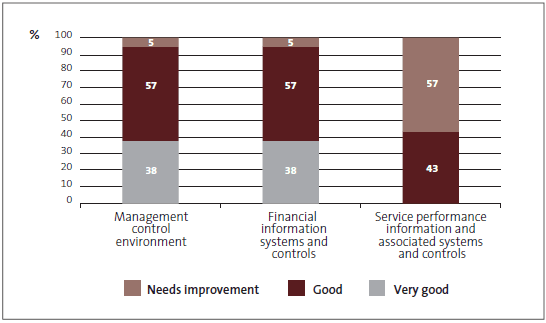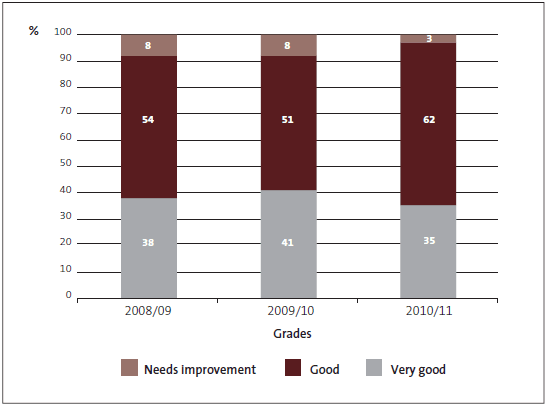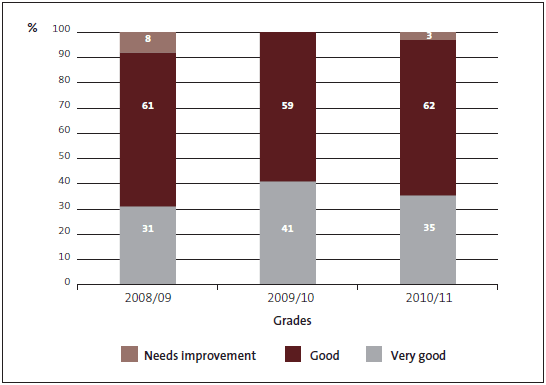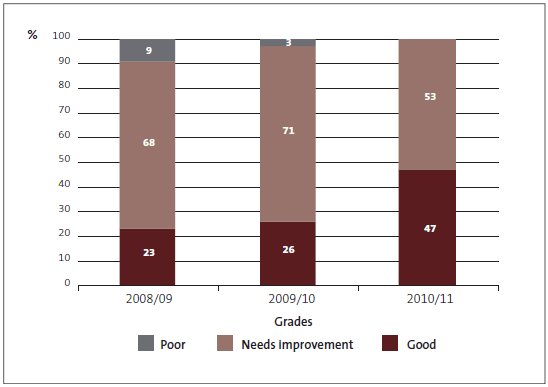Part 6: Results of government department audits
6.1
In this Part, we report on the results of our audits of government departments16 in 2010/11, including our assessments of their management control environments, financial information systems, and service performance information and associated systems and controls.
6.2
Part 7 sets out the results of our audits and our assessments for Crown Research Institutes. We will report the results of our audits of State-owned enterprises, district health boards, and other Crown entities in early 2012.
Central government changes
6.3
The global financial crisis has focused the Government's attention on lifting the performance of the public sector while reducing the rate of spending increases. The Government is focused on "delivering better, smarter public services for less", and change and improvement programmes continue to be rolled out throughout central government.
6.4
The Government has introduced many initiatives to secure the right capability and capacity to deliver effective and efficient public services and has made some structural changes (including four departmental mergers).
6.5
There were 37 government departments as at 30 June 2011,17 two fewer than at 30 June 2010 and 30 June 2009.
6.6
A new entity was established in March 2011 to manage issues arising from the Canterbury earthquakes (the Canterbury Earthquake Recovery Authority, or CERA). We have not included CERA's results in this Part because its full annual report will be audited, for the first time, for the period 29 March 2011 to 30 June 2012.18
Audit reports for 2010/11
6.7
We audited 41 government departments in 2010/11, excluding the Government Security Bureau and the New Zealand Security Intelligence Service. The 41 audits include the final audits for four departments that were disestablished during the year and the 37 existing19 at 30 June 2011 (which includes one new department – the Ministry of Science and Innovation – and two Offices of Parliament – the Office of the Ombudsmen and the Office of the Parliamentary Commissioner for the Environment were transferred to the Auditor-General to audit in 2010/11).
6.8
We issued unmodified audit opinions for all 41 departments for the year ended 30 June 2011.
6.9
In two audit reports (for the Department of Building and Housing and the Department of Internal Affairs), there was an explanatory paragraph drawing readers' attention to particular matters: the assumptions underpinning the provision made for the Government's financial assistance package for owners of leaky homes, in the first instance, and the estimates and assumptions about the figures for the Canterbury earthquakes, in the second.
Final audits for disestablishing departments
6.10
We carried out final audits for four departments that were disestablished during 2010/11 and merged into other departments:
- Archives New Zealand, disestablished on 31 January 2011 and amalgamated into the Department of Internal Affairs (DIA);
- the National Library of New Zealand, disestablished on 31 January 2011 and amalgamated into DIA;
- the Ministry of Fisheries, disestablished on 30 June 2011 and amalgamated into the Ministry of Agriculture; and
- the Ministry of Research, Science and Technology, disestablished on 31 January 2011 and amalgamated with the Foundation for Research, Science and Technology to form the Ministry of Science and Innovation.
6.11
For all four departments, our audit report included an explanatory paragraph highlighting that the financial statements were appropriately prepared on a disestablishment basis.
6.12
We did not assess the entity's environment, systems, and controls when we carried out the final audit. This is because the grades we give reflect our recommendations for improvement, and deficiencies identified during the final audit of a disestablishing entity may or may not be relevant to any new or ongoing entity.
6.13
However, we did report our audit findings and any significant issues to the responsible Minister, and we commented on the operation of the environment, systems, and controls during the disestablishment period. Overall, our appointed auditors found that the four disestablishing entities maintained sound systems and controls up until disestablishment. Two departments faced capability loss with staff leaving but managed to maintain most activities and controls either by contracting staff or through effective deployment of existing staff. However, some systems and controls were not maintained, including no formal risk management processes in one department, no internal audit programme in another, and in two departments legislative compliance systems and procedures were not fully carried out during the period.
Matters of audit interest in the other departments
6.14
We reported on some matters of interest drawn from our audits of the 37 other departments.
6.15
Central among these were the implications of the Canterbury earthquakes. These ranged from uncertainties about valuation/costs arising from the earthquake damage to the effect of the earthquakes on departments' attempts to achieve efficiencies and on risk and internal assurance mechanisms.
6.16
Other issues we drew attention to, and the number of departments that each applied to, included:
- management risks associated with structural changes, such as restructuring costs, loss of institutional knowledge, or weakening of internal controls (six departments);
- weaknesses in procurement practice (six departments);
- unappropriated expenditure (six departments);
- weaknesses in financial management (four departments);
- weakness in forecasting demand, some of which resulted from the Canterbury earthquakes (three departments);
- effect of weaknesses in the department's expenditure review process on savings projections (one department);
- uncertainties arising from carbon emissions control policies (one department);
- project management arrangements that needed to improve, including the need for an acquisition strategy and for a clearer focus on value for money, estimates that were not robust enough, and reporting that was not regular enough (one department); and
- debt recovery and the need to effectively collect fines (one department).
Environment, systems, and controls
6.17
As part of the annual audit, we examine, assess, and grade central government entities' environment, systems, and controls for managing and reporting financial and service performance information.
6.18
This is the fifth year that we have used our current assessment framework to support the continued improvement of public entities. We assess three aspects:
- the management control environment;
- financial information systems and controls; and
- service performance information and associated systems and controls.
6.19
The auditors we appoint to audit public entities identify deficiencies in each of these aspects and make recommendations for improvement. The grades assigned reflect the recommendations for improvement as at the end of the financial year. Figure 2 explains these grades.
Figure 2
Grading scale for assessing public entities' environment, systems, and controls
| Grade | Explanation of grade |
|---|---|
| Very good | No improvements are necessary. |
| Good | Improvements would be beneficial and we recommend that the entity address these. |
| Needs improvement | Improvements are necessary and we recommend that the entity address these at the earliest reasonable opportunity. |
| Poor | Major improvements are required and we recommend that the entity urgently address these. |
6.20
We report our assessments to the department, the responsible Minister, and the relevant select committees. We also advise the central agencies: the Treasury, the State Services Commission, and the Department of the Prime Minister and Cabinet.
Grades for 2010/11
6.21
We assessed and graded 37 government departments in 2010/11, including, for the first time, one new department (the Ministry of Science and Innovation) and the two Offices of Parliament. Figure 3 sets out a summary of the grades for departments for 2010/11 for the three aspects that we assess.
Figure 3
Summary of grades for the 37 government departments audited for 2010/11

6.22
Overall, the results for 2010/11 show that government departments have generally sound management control environments and financial information systems and controls. We graded 95% of the departments as "Good" (needing beneficial improvements only) or "Very good" (no improvements identified as being needed) in each of these aspects.
6.23
However, for the year ended 30 June 2011, only 43% of the departments had a "Good" grade (and none had "Very good") for service performance information and associated systems and controls. The rest (57%) were graded as needing improvement at the earliest reasonable opportunity. No departments were graded "Poor" in 2010/11.
Trends in environment, systems, and controls
6.24
We have in the past reported trends for each of the three aspects. As the group of departments has changed for 2010/11, with only 34 departments in the group for all of the last three years (2008/09, 2009/10, and 2010/11), we are able to give trend data for only those 34 departments. This is set out in Figures 4 to 6.20
Figure 4
Management control environment – grades of the 34 departments graded in all of the three years, 2008/09, 2009/10, and 2010/11

Figure 5
Financial information systems and controls – grades of the 34 departments graded in all of the three years, 2008/09, 2009/10, and 2010/11

6.25
For both the management control environment and the financial information and controls aspects, the performance of the 34 government departments has been mainly in the "Good" or "Very good" range during the last three years. Results for service performance reporting have been less pleasing, but are improving.
Figure 6
Service performance information and associated systems and controls – grades of the 34 departments graded in all of the three years, 2008/09, 2009/10, and 2010/11

Improvements in reporting service performance information
6.26
An improvement in reporting service performance information is apparent in 2010/11. We did not grade any departments as "Poor", we graded almost half of the departments as "Good" (about 80% more than in 2009/10), and the percentage of those needing improvement had dropped by a quarter (to 53%) between 2009/10 and 2010/11.
6.27
In 2010/11, we applied our revised standard to auditing the service performance information of 19 departments. Pleasingly, none of these departments received modified audit opinions on their service performance information. In Part 9, we discuss our work to help public entities improve their service performance information and reporting.
16: "Government departments" includes the two Offices of Parliament that we audited.
17: Excluding the Canterbury Earthquake Recovery Authority, CERA (see paragraph 6.6).
18: Only CERA's statements of appropriations were audited because a full annual report was not required for the period from 29 March 2011, when it was established, to 30 June 2011.
19: Excluding CERA.
20: The proportions for 2010/11 differ slightly in Figures 4 to 6 from those in Figure 3 because of the difference in the number of departments when looking at trends for the years from 2008/09 to 2010/11 (34 departments) compared with the number of departments (37) in 2010/11.
page top